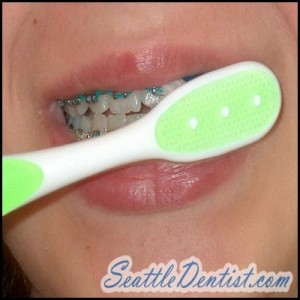-
July 22nd, 2010articles
The most difficult part of wearing braces is thoroughly cleaning them. There are hard-to-reach areas that don’t seem to get penetrated even by thorough brushing. In this article, we will teach how to use the most efficient method in brushing teeth with braces and also the foods to avoid while you are on braces.
First things first. Braces require the utmost attention and care of any dental appliance, because braces usually last two to four years and dislocations of the brackets may lead to a visit to the dental clinic, resulting to unwanted fees. Braces are, by fact, the toughest dental appliance to clean. People who wear braces are faced with the responsibility of brushing their teeth after every meal (especially after eating seafood) and before going to sleep. The reason being that food debris clings on to teeth with braces even after gargling.

It is also imperative to know what kinds of food are recommended to people who wear braces. Dentists recommend easy-to-chew, well-cooked and soft foods, to avoid breakage and misalignment of braces. The types food you should avoid are:
1.) Tough-to-bite and touch-to-chew foods – 80% of dental appliance breakages are caused by eating hard foods. The wire in the brace is not very tough, so when biting hard foods, be sure to direct the bite to the second and third molars and not to the front teeth and cuspids to avoid loosening of the brackets.
2.) Uncooked food – obviously a breeding ground for bacteria and other vicious elements, uncooked food is definitely unsafe to eat when one wears braces. The bacteria may nest in hidden parts of the teeth, thus making it harder to clean and may promote unnoticed tartar buildup.
3.) Acidic foods and drinks – braces are metallic devices and therefore are prone to stains that, in turn, may collude with the surface of the tooth, causing permanent stains.
4.) Foods with high sugar content/sticky foods - sweet foods that leave a residue of stickiness on the teeth may cause a variety of unsightly dental conditions in the long run. As you may know, high sucrose content is the catalyst for plaque buildup, and what more if that sticky material latches on to the surface of the teeth and in-between the braces.
5.) Gum – gum is not prohibited when wearing braces, but because of the high sugar content most gums have and the risks that it imposes, it is advised to eat only sugarless gum.
As you may have noticed, hard foods are number one on the list of foods to avoid. Why? Because hard foods usually require the full aid of the front teeth to do initiate the bite. This, in turn, leads to a more stringent bite, that may cause the food to pull the wires, thereby dislocating the brackets on the front teeth.
Avoiding sugary foods is also very important. Plaque and tartar buildup for people with braces is very, very high. People who wear braces are often faced with the long-term predicament of yellowish to blackish pigments on their front teeth.
It is very important to use a specialized toothbrush called a “proxibrush” to clean in-between teeth and areas just beneath the brackets. A proxibrush is approximately seven inches in length and is primarily used in cleaning the front surface of the teeth and braces. Apply a thin lather of fluoride toothpaste on the bristles of the proxibrush. Brushing starts from the back of the teeth all the way to the front. Pressure definitely need not be applied and there should also be utmost discretion in cleaning hard-to-reach parts: routinely clean with gentle strokes. If an area of the teeth cannot be cleaned, do not force the proxibrush or else the brackets may loosen.
People can also use a proxibrush alongside a regular toothbrush. While using a regular toothbrush on initial cleaning of the teeth, remember to brush really gently and focus on the brushing the back surface of the teeth and scraping the tongue, since the main task of the proxibrush is to clean the front surface of the teeth.
Proxibrushes are also like regular toothbrushes, which need to be replaced every three months and should be soaked in warm water whenever possible to avoid bacteria buildup on the bristles.
It is always important to carry a proxibrush or two around with you, especially on out-of-town trips.
This article is only a general guide in brushing teeth with braces. It is much more recommended that one consults the dentist regarding the proper regimen that on brushing the teeth, respective to the type of braces that you are wearing.

